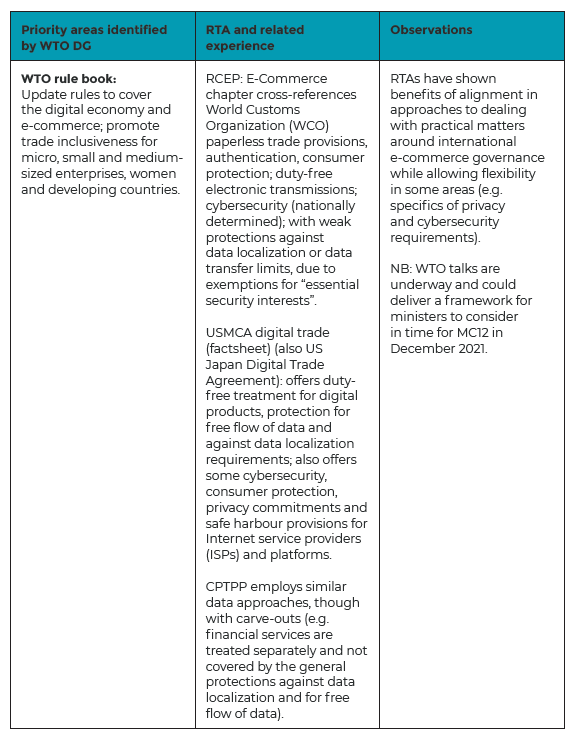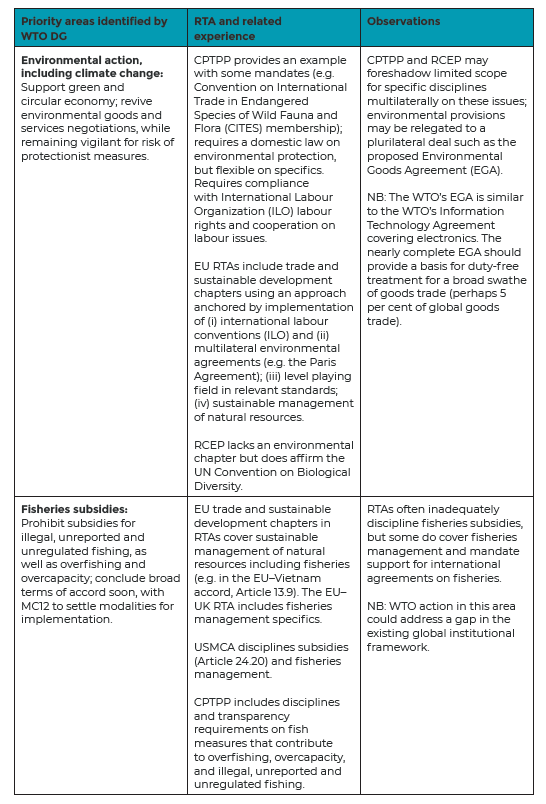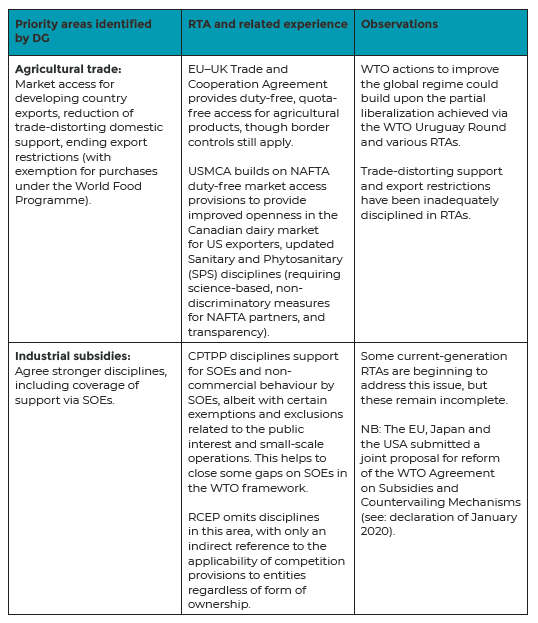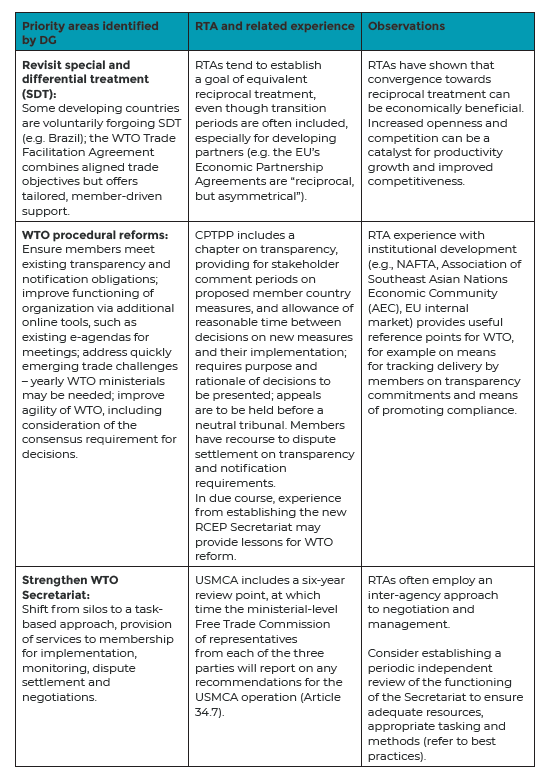The first two decades of this millennium were marked by major political, economic and geopolitical disruptions. This has led many analysts to predict that the world economy is entering a phase of “deglobalization” that is, a retreat from the globalization process. This policy brief discusses how “deglobalization” affects the role and relevance of international trade institutions and agreements. The basic message is that investing in the improvement of the rules-based multilateral trading system and its main institutional anchor, the World Trade Organization (WTO), is of critical global importance to maintain non-discriminatory and fair trade relations, while recognizing the diversity of goals that different countries may legitimately pursue in the public interest.
Challenge
Gaps in World Trade Organization (WTO) disciplines and the fact that domestic regulations vary imply that a level playing field is not guaranteed. How to achieve proper and effective implementation of the agreed rules of the multilateral trading system by all the contracting parties? How to update the existing rule book to clarify the rules in areas where frictions have emerged (e.g. subsidies and state support)? How to cover gaps in the rule book, whether old ones in agriculture and traditional services or new ones associated with technological change (e.g. e-commerce), the environment and the post-pandemic recovery? Is the current balance in WTO obligations between the advanced and the developing economies appropriate? Increasingly, members are looking to plurilateral agreements in the WTO and regional accords as means to respond to current trade requirements. This highlights a risk of fragmentation in the system. Where disputes have arisen, some members have applied domestic trade restrictive measures and countermeasures without appropriate regard to WTO commitments and rules, further adding to the difficulties. Contesting such actions in the WTO Dispute Settlement System (DSS) has lost effectiveness as the Appellate Body (AB) is no longer operating due to blockage in the appointment of adjudicators. This policy brief draws on lessons from the experience with regional trade agreements and investment treaties and suggests options for handling these pressing, systemically important trade challenges of the 21st century.
CONTEXT
IS IT “DEGLOBALIZATION” OR A “RESHAPED GLOBALIZATION”?
The process of international economic integration, a major driver of the globalization process and of economic growth, has been slowing down since the global financial crisis (2008-09). The last decade has witnessed a decline in the growth of international trade in merchandise, a slowdown in the dynamism of global value chains (GVCs) and significant declines in international capital flows.
It is also true that some aspects of the globalization process continued to evolve in a dynamic fashion. International immigration numbers and data flows via digital channels are two examples. Some dimensions of trade were reshaped as trade was virtualized thanks to technological developments.
Even though a substantial share of world trade continues to be conducted under most-favoured-nation (MFN) terms, the COVID-19 pandemic has compounded the problems for international economic integration, particularly with respect to international travel and via the adoption of restrictive policies for trade in medical inputs and vaccines. At the same time, the pandemic fostered cross-border services flows (via e-commerce), once again underscoring the many facets of the globalization process.
THE NEED FOR REFORM
Unless stakeholders invest in the functioning of the multilateral trade system and its main institutional anchor, the WTO, the period ahead may be characterized by further trade tensions, magnifying the danger of “deglobalization” (see Akman et al., 2020; Sacerdoti, 2021). The WTO is facing many challenges, including how to achieve proper and effective implementation of the agreed rules of the system by all the contracting parties; how to update the existing rule book to clarify the rules in areas where frictions have emerged (e.g. on subsidies and state support) to ensure a level playing field in the new competitive environment and to cover gaps, whether old ones in agriculture and services or new ones opened by technological change (e.g. e-commerce); and the importance of the restoration of the functioning of the DSS and the AB to ensure clarity and predictability in the meaning and application of the WTO rules.
BUILDING MULTILATERALLY WITH MEGA-REGIONAL BRICKS
The WTO has struggled to deliver results in its key functional areas of trade negotiations, trade policy monitoring and dispute resolution. Many WTO members have turned to preferential trade liberalization efforts as a more expeditious means to address pressing trade challenges. Three major mega-regional accords have successfully advanced to conclusion over the past three years: the Comprehensive and Progressive Agreement for Trans-Pacific Partnership (CPTPP) in the Pacific Basin, the Regional Comprehensive Economic Partnership (RCEP1) in Asia and the Pacific, and the United States-Mexico-Canada Agreement (USMCA) in North America. WTO members have accumulated a wealth of experience from such accords.
Regionalism and preferential agreements may help to avoid the complex and time-consuming need to achieve a global consensus at the WTO. Using the regional trade agreement (RTA) route, like-minded countries may be able to advance more quickly to deliver greater liberalization than might be doable via the WTO. Where RTA liberalization delivers benefits, it can attract new members or efforts to replicate such arrangements. The discriminatory impacts on non-participants may then fuel calls to make the terms of these arrangements universal.2 Table 1, in the Appendix, highlights some illustrative cross-references between the WTO Director-General’s (DG) listing of member priorities and the approaches found in current-generation mega-RTAs.
NEXT STEPS
How might WTO members advance based on this experience? For instance, in the case of trade and environment, one option might be to simply mandate membership in relevant existing multilateral environmental agreements. Another option in that regard might be to negotiate a requirement that members have in place a statute on environmental protection, even if the exact terms of protection are left open and determined at the domestic level. In other cases, a plurilateral opt-in arrangement may provide a vehicle for generalizing a particular lesson from RTAs. For example, some RTAs have advanced services disciplines by requiring transparency, stakeholder consultation and contestability in trade-related regulatory processes.
If a traditional binding trade agreement is not immediately doable at the WTO, it may still be possible to establish a working group to promote convergence. Mega-RTAs are generally meant to be living agreements that evolve using standing bodies to monitor, consult and cooperate. A similar structured approach could be applied via a WTO committee of interested members. This may permit progress in sensitive areas such as protection of trade secrets (an unfinished point of business under the Trade-Related Aspects of Intellectual Property Rights (TRIPS) Agreement) (see Lippoldt and Schultz, 2014).
LESSONS FROM OTHER AGREEMENTS
It is difficult to imagine that any major reform of the WTO or any new multilateral or plurilateral deal will succeed without the concurrence of the major trading powers.3 The content of the China-EU Comprehensive Agreement on Investment (CAI), which was concluded in December 2020 and awaits ratification, is worth mentioning in this context. The CAI focuses on aspects of investment relations that are usually neglected, therefore some of its provisions may serve as examples for other countries. The agreement has potentially important systemic implications because it covers rules on subsidies and state-owned enterprises (SOEs), which have been a bone of contention at the WTO.
In the services sector, the CAI binds China’s unilateral liberalization for the benefit of European Union firms. Comparing the CAI with China’s WTO commitments under Mode 3, there are several improvements, primarily, China opens to foreign investment in a number of sectors that were previously not covered in its General Agreement on Trade in Services (GATS) schedule.
The CAI also contains an obligation for the parties not to “impose or enforce any requirement or enforce any commitment or undertaking … to transfer technology, a production process, or other proprietary knowledge to a natural person or an enterprise in its territory”. The words “impose or enforce” are crucial (see Mavroidis and Sapir, 2021). They imply that the parties to the agreement cannot impose technology transfer (TT) requirements on foreign firms that want to invest or have invested in their jurisdictions.
The CAI contains a precise and comprehensive definition of SOEs by applying rules to SOEs at all levels of government, including local government. The CAI’s disciplines on subsidies in services also represent a major improvement since the WTO only covers subsidies in goods trade. The intention to negotiate disciplines on subsidies in services was included in Article XV of GATS, but these negotiations never took off.
WTO LAW AND SOES
SOEs play an important role in the global economy.4 There is no textual reference to the term “SOEs” in the WTO agreements. The WTO places no restriction on their operations, provided they operate on a commercial basis. Until very recently, trade scholars barely even mentioned SOEs because they were not seen as a WTO problem. But there is no doubt that many provisions of the WTO are applicable to SOEs.
Recognizing the limitations of general multilateral trade rules, WTO members chose to add customized disciplines for certain members on an ad hoc basis through the contracting process of the negotiation of protocols of accession. China’s Protocol of Accession includes the most elaborated provisions on non-market economies (NMEs), as well as additional constraints on the activities of SOEs (see WTO, 2001). However, even these additional provisions are not considered adequate to cover the pervasive nature of the issue currently. Moreover, the discipline on subsidies to SOEs is solely applied to subsidies contingent on the trade in goods.
In the absence of a shared definition of SOEs and of any understanding of the reasons why these enterprises should be subjected to multilateral rules, it is not possible to derive a general duty of transparency on the impact of negative spillovers on the trading system as a result of SOEs’ operations. Potential lessons from the CAI text could be taken into account when addressing this issue multilaterally at the WTO.
THE DSS: FROM A SUCCESS STORY TO A PARALYSING CRISIS
The WTO dispute settlement system has operated to the satisfaction of most members and other stakeholders for more than twenty years. The system worked relatively smoothly until 2017, when the DSS started to show fatigue, especially due to the length of proceedings which went well beyond the speedy resolution that had been envisaged. Rising complexity and numbers of disputes were the main contributors to the strain.
With the continued blocking of new appointments, by which the USA signalled its dissatisfaction with the operation of the AB and its results, the AB had to cease operations in 2019 due to a lack of judges. Panel proceedings, while continuing to take place, are ultimately ineffective. Losing parties are able to systematically appeal unfavourable panel reports to the non-operational AB, thus paralysing the DSS outcomes.
In 2018, New Zealand’s Ambassador David Walker, then chair of the General Council, was appointed as “Facilitator” to unblock the stalemate. His technical proposals (“quick-fix”) are considered by most WTO members to be adequate or, in any case, to provide a good basis for resolving the issues. We concur with this evaluation. The stability of case law is important to ensure the predictability of the rules, since interpretation of any provision in dispute by the AB is relevant for all members. This does not mean that precedents should be binding per se, a statement that in fact the AB has never endorsed.
WTO REFORM: A CLUB OF CLUBS APPROACH?
The modus operandi of the WTO needs to be rethought to reflect changes in the global economy, the diversity of its membership and the increased range of trade issues it is required to tackle. The WTO must find new ways to advance open and predictable trade without abandoning its basic principles of non-discrimination (most-favoured nation, MFN; national treatment, NT). It must move from a mindset where everyone has to agree on everything for any deal to be struck, to one where deals are struck as waypoints towards the ultimate objective.
Waypoints are not novel to the organization, even if it is not always thought of as such. For example, under Special and Differential Treatment (SDT), developing countries retain certain flexibilities until they self-designate as advanced countries. Under Article XXIV of the General Agreement on Tariffs and Trade (GATT) and Article V of the GATS, members can strike regional agreements that discriminate against other members provided they fulfil certain conditions.
Other examples of waypoints in the WTO are plurilateral agreements. These include agreements that do not bind all members and are not MFN (e.g. the Government Procurement Agreement, GPA 1994, signed at the end of the Uruguay Round) and “critical mass” agreements in which members accounting for a large share of trade undertake obligations but allow the benefits of the agreement to be applied on an MFN basis. These agreements can be effective waypoints towards non-discrimination insofar as they have reasonable provisions for acceding to them.
Changing the mindset of the WTO from the pursuit of difficult-to-achieve universal deals to regional and plurilateral waypoints towards freer world trade means that the WTO needs to move in the direction of a “club of clubs” approach as suggested by Lawrence (2006). In Lawrence’s conception, the “clubs” are plurilateral agreements, but one could explore the concept in the context of other exceptions to non-discrimination under WTO rules.
As a club of clubs, the WTO would actively promote trade opening and predictability in all its forms: regional, plurilateral and multilateral. It would support these processes through hard disciplines when possible that is, in international treaties subject to legal recourse but also through softer consultation, coordination and peer review mechanisms (as in the Organisation for Economic Co-operation and Development (OECD) or the Stability Forum).
Proposal
In order to improve the functioning and centrality of the WTO, prevent further politicization of trade and address sensitive trade matters, the following recommendations, taken in the order they were raised in the text, are suggested:
- Recommendation 1: National security and public morals are valid exceptions to the application of multilateral rules, but they should not be abused. As a first step, members should commit to a credible standstill on new trade-restrictive measures, including trade-distorting subsidies. Unilateral restrictive measures destabilize global value chains and put at risk one of the main positive results of trade liberalization, stability and predictability of the trade regime for all. Legitimate national concerns, such as the availability of medical devices and vaccines in the face of pandemics, should be addressed through enhanced cooperation and mutual support rather than through unilateral measures.
- Recommendation 2: In developing WTO responses to new issues at the multilateral level, due reference should be made to the experience of existing RTAs, with a view to adapting and generalizing lessons where appropriate. In each of the member country priority areas cited by DG Ngozi Okonjo-Iweala upon her appointment, there are relevant insights to be drawn from recent RTAs.
- Recommendation 3: On issues where a formal, binding international trade agreement is not yet doable, it may be possible to promote convergence and coordination via issue-specific focused dialogue on emerging trends in trade-related policies, standards and regulation, including development of best practices and recommendations. Recent RTAs such as the CPTPP and RCEP provide examples of structures developed with such objectives in mind, as does the experience with soft law development at the OECD.
- Recommendation 4: The proposed EU-China CAI provides a relevant illustration of means to bridge divisive issues between leading trading nations with different domestic economic models. Potentially relevant examples include the agreement’s precise and comprehensive definition of SOEs, disciplines on subsidies in covered services, commitments on labour and environmental standards, and transparency provisions.
- Recommendation 5: Potential multilateral disciplines on SOEs should consider the experience in recent regional trade agreements (e.g., the CPTPP and USMCA) with obligations related to non-discrimination and commercial considerations. These cover services and investment, domestic operations of firms, respect for the principle of national treatment, and SOE compliance with requirements for non-discrimination and commercial considerations.
- Recommendation 6: The Agreement on Subsidies and Countervailing Measures (ASCM) could be updated, drawing on RTA experiences by providing an illustrative list of public bodies and their characteristics, including with respect to SOEs. This would reduce uncertainty in the application of the relevant rules. Under the potential reform of the WTO dispute settlement mechanism, cases related to the ASCM should be informed by the proposed illustrative list of public bodies in the ASCM, but the Dispute Settlement Body (DSB) or other committees should be empowered to provide further clarification within the bounds of the illustrative list.
- Recommendation 7: The promptness of DSS proceedings is important and should be reinstated at all levels, including panels, appeal and compliance, through appropriate updating of relevant procedural rules (including improved efficiency of panel proceedings) and by administrative and financial arrangement within the WTO. A smother functioning of the negotiating process of the WTO could help reduce the pressure on the DSS. This could include giving guidance and authoritative interpretations of contentious issues and provisions (under Art. IX.2 WTO Agreement or otherwise). Work on updating the DSS should start promptly and be carried out speedily as a priority.
- Recommendation 8: WTO reforms should include improved transparency and notifications, particularly with respect to subsidies. The rule making in this area should focus on creating incentives for WTO members to fully comply with their notification obligations. Transparency is the basis of trust. The system cannot rely solely on notifications by governments. The Secretariat has shown it is fully capable of collecting public information and organizing it in order to enhance transparency. The Secretariat should be instructed or encouraged to use its resources in cooperation with other international agencies in advancing this agenda.
- Recommendation 9: Where universally applicable trade rules are currently out of reach, the WTO should be able to flexibly accommodate regional and plurilateral agreements under its auspices. The conclusion of negotiations under Joint Statement Initiatives (JSIs) for example the JSI on Services Domestic Regulation and the JSI on Investment Facilitation could be a good starting point. This approach would promote further liberalization (including via more proactive engagement of the Secretariat and committees) while also fostering conformity of any such partial agreements with existing WTO rules.
- Recommendation 10: Through its Trade Policy Reviews, and in cooperation with the World Bank and others, the WTO should play a far more active role in the arena of domestic trade reforms and promotion of unilateral trade liberalization. This could include provision of advisory support drawing on the cumulative experience of members, relevant international organizations and the WTO Secretariat.
APPENDIX
Table 1. WTO DG priorities and regional trade agreements: An illustrative comparison


Table 1. WTO DG priorities and regional trade agreements:
An illustrative comparison (cont’d)

Table 1. WTO DG priorities and regional trade agreements: An illustrative comparison (cont’d)


Sources: WTO, Dr. Ngozi Okonjo-Iweala, (i) Special General Council meeting, post-election
WTO press conference, 15 February 2021 and (ii) statement to the WTO General Council, Job/
GC/250, 16 February 2021. Other sources are linked.
NOTES
1 RCEP ratification is still pending.
2 For a less optimistic view of the role of RTAs in supporting multilateral liberalization see Hughes Hallett and Primo Braga (1994).
3 This section of the brief is based on Dadush and Sapir (2021).
4 This section of the brief relies on Borlini (2020).
REFERENCES
Akman S, Berger A, Botti F, Draper P, Freytag A, Padoan PC, and Schmucker C. (2020). The Need for WTO Reform: Where to Start in Governing World Trade. T20 Policy Brief, Saudi Arabia, https://t20saudiarabia.org.sa/en/briefs/Documents/T20_TF1_PB1.pdf
Borlini L (2020). When the Leviathan goes to the market: A critical evaluation of the rules governing state-owned enterprises in trade agreements. Leiden Journal of International Law, 33(2):313-334
Dadush U, Sapir A (2021). Is the European Union’s investment agreement with China underrated? Policy Contribution 09/2021. Brussels: Bruegel, 13 April
Hughes Hallett A, Primo Braga CA (1994). The new regionalism and the threat of protectionism. World Bank Policy Research Working Paper 1349, August
Lawrence RZ (2006). Rulemaking amidst growing diversity: a club-of-clubs approach to WTO reform and new issue selection. Journal of International Economic Law, 9(4):823-835
Lippoldt D, Schultz MF (2014). Trade Secrets, Innovation and the WTO. E-15 Think Piece. Geneva: ICTSD and WEF, with IMD
Mavroidis PC, Sapir A (2021). China and the WTO: Why Multilateralism Still Matters. Princeton, NJ: Princeton University Press
Okonjo-Iweala N (2021). Statement of the Director-General Elect Dr. Ngozi Okonjo-Iweala to the Special Session of the WTO General Council. WTO Job/GC/250, 15 February
Sacerdoti G (2021). The challenge of countering politicization of trade relations and revitalizing the multilateral rule-based system (Editorial). Journal of World Investment & Trade, 22:1-12
WTO (World Trade Organization) (2001). Protocol on the accession of the People’s Republic of China, WT/L/432, 23 November
Zhang C (2019). How Much Do StateOwned Enterprises Contribute to China’s GDP and Employment? Washington, D.C.: The World Bank








